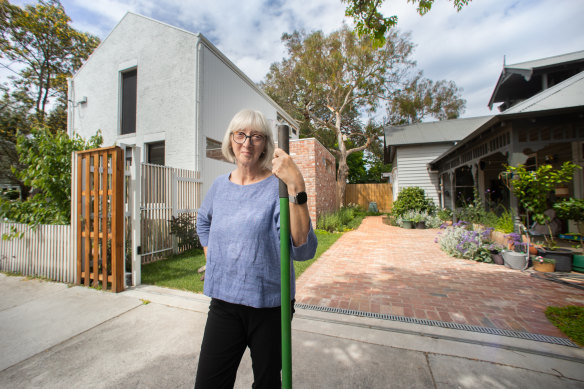By Rachel Eddie and Kieran Rooney
Victorians subdivided their block of land into two homes 2700 times last year, but the Allan government’s bid to boost that number could be hampered by Melbourne’s long narrow lots, experts warn.
While planners and industry figures welcomed last month’s announcement to encourage more two-lot subdivisions from April 2025, they said allowing many more subdivisions on larger plots of land were needed to make townhouses attractive and affordable to more buyers.

Maddy McMaster had a second home built on her Northcote lot, and now shares the block with her son.Credit: Simon Schluter
The potential loss of green space and tree canopy coverage would also have to be addressed, the industry figures said.
Planning Institute of Australia Victorian president Patrick Fensham said the government should aim to amalgamate multiple blocks of land, including by buying them and potentially redrawing boundaries, to allow for larger mixed-use development and to ensure vegetation wasn’t lost.
The 2700 lots subdivided to create two homes, averaging 700 square metres, comprised more than half of the total 5128 multi-lot subdivisions in 2023. Across all subdivisions, only 53 per cent were determined within the statutory 60-day timeframe.
Instead, the turnarounds averaged 275 days, or nine months, including time taken by the applicant to provide further information once lodged.
The government is considering fast-tracking applications to a 10-day process, exempting them from permits if they meet certain criteria, or requiring no permit at all.
Maddy McMaster wanted to downsize until her son floated the idea of building a second home on her Northcote lot. Now completed, she lives in the new home while her son and his partner moved into the existing family home.
McMaster said the owners of two other properties in her street were doing the same, and in both cases parents aimed to create affordable housing for their children.
“We share the garden, we share a dog. We don’t live in each other’s pockets at all, but we see each other quite regularly, and we’re there to help each other out,” she said.
McMaster said the planning approval process was “torturous”, as council systems were not well-suited to her family’s request to build a second home without subdividing the land.
Fensham said the detail of the government policy would be important, but expected the change would only marginally increase the likelihood of more subdivisions. Owners would still have to be confident of selling at a profit, he said.
“This is making it easier to do what’s occurring a lot anyway,” Fensham said. “I don’t think it’s all of a sudden going to open up new opportunities.”
He said two-lot subdivisions were a popular and attractive form of development, by avoiding body corporates while continuing to offer larger dwellings with private parking and open space.
But he said that would only double density when in some cases, five times the density would be a better outcome.
Maxwell Shifman, the chief executive at Intrapac Property and a former president of the Urban Development Institute of Australia, said homes on subdivided properties were quick to build, delivered a good space-to-price ratio compared with apartments and had a relatively low impact on neighbourhoods.
But he said the difference to supply would be incremental at best.

Swinburne University’s Dr Stephen Glackin.Credit: Joe Armao
Shifman said loosening the policy to two occupancies was unlikely to create homes that were affordable to most buyers, with four to six smaller dwellings on a standard residential lot needed to bring prices down.
“It’s not a solution for delivering the tens of thousands of homes needed in established areas,” he said.
“The only feasible way to achieve what the state government wants from townhouse development, at price points that bring more people into the market, and at the scale it needs, is to facilitate it efficiently on larger sites.”
Dr Stephen Glackin, a senior research fellow at Swinburne University’s Centre for Urban Transitions, agreed that a key issue remained “site assembly”, referring to the challenge of getting multiple adjoining lots developed together because a single lot might be too narrow.
“If you don’t have site assembly, you’re not going to get really anything of scale on the single suburban lots,” he said.
Glackin said the current system was restrictive and at times encouraged poor outcomes.
He suggested a streamlined process could be used in areas where townhouses were already present for neighbouring properties with similar designs.
The planning institute is yet to formalise a position, but Fensham agreed the government could consider that minimum design criteria be part of the streamlined process to ensure streetscapes did not become driveways and garages on long narrow lots at a cost to green space and vegetation.
He called on the government to require all the developments make a financial contribution to local infrastructure.
Forty-three of Victoria’s 79 councils collect developer contributions in different ways. Where they do exist, two-lot subdivisions can be exempt from making a contribution to public open space if the council considers it unlikely the lot would be further subdivided.
Premier Jacinta Allan is reviewing these contributions to ensure every new home adds to local infrastructure under a statewide model.
A government spokesman said the two-lot subdivision process would be streamlined with clear limits such as setbacks, building height, site coverage, parking and trees.
“If you’ve got land you don’t need, we’ll make it easier for you to subdivide it and sell it, putting money back in your pocket and giving another Victorian the chance to buy their own home,” he said.
Architect Ben Callery, who designed McMaster’s home, said planning rules had required them to build a fence separating the homes, despite McMaster and her son not wanting one.
“This particular planning process took almost a year,” Callery said.

Linda Allison, of the Urban Development Institute of Australia, says it’s important to allow a wide range of housing across the state.Credit: Louis Trerise
Linda Allison, the Victorian chief executive of the Urban Development Institute of Australia, said it was important to allow a wide range of housing across the state to offer people a choice.
Allison said the government’s proposal could cut the lengthy process and cost of delivering extra houses and townhouses in well-connected suburbs through gentle development.
Start the day with a summary of the day’s most important and interesting stories, analysis and insights. Sign up for our Morning Edition newsletter.